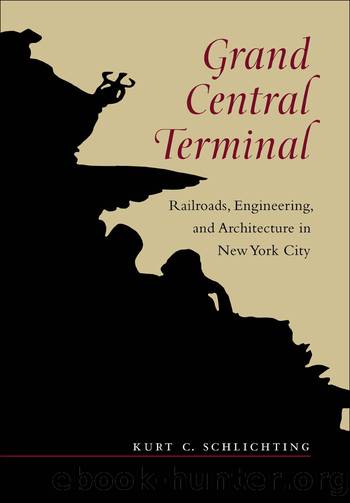Grand Central Terminal by Kurt C. Schlichting

Author:Kurt C. Schlichting
Language: eng
Format: epub
Publisher: Johns Hopkins University Press
Published: 2001-02-14T16:00:00+00:00
Controversy
Controversy over credit for the design of Grand Central continued for years. William Wilgus took credit for the idea of a two-story underground terminal powered by electricity and for using the air rights to pay for the vast changes planned for the 42nd Street station. He never claimed any credit for the architectural design of the terminal building itself; a brilliant engineer, Wilgus had no training or expertise as an architect. In turn, Wilgus attributed to Reed and Stem the idea for the elevated roadway around the building and the arched bridge carrying Park Avenue over 42nd Street.
Warren and Wetmoreâs major contributions included replacing the twelve-story revenue building, proposed by Wilgus and Reed and Stem, with a lower but more monumental structure devoted to railroad functions with limited commercial space. Warren and Wetmoreâs design proclaimed the glory and might of the New York Central Railroad by adopting the language of the Beaux-Arts in a classical, low-rise building with arches and portals crowned by ornamental statues and detailing. Warren focused on the monumental aspect, rather than the mundane world of square footage and rental income. In addition, Warrenâs building did not include the elevated driveways of Reed and Stemâs design. Wilgus, angered at the decision to abandon both the revenue-producing building and the elevated roadways, maintained that Warrenâs design involved only the exterior treatment of the station and did not alter the essential circulation and separation of functions he had originally proposed to Newman in 1903. Wilgus summarized the changes from his perspective: âThe Company, however, while not approving the change from the fundamental features of the original inception, contrary to the views of its Vice President [Wilgus], concluded that the exterior treatment of the station proper, consisting of a low monumental effect without the elevated driveway and 42nd Street bridge, was preferable to the revenue producing type with the Reed and Stem driveways.â6 To the end of his life, Wilgus remained embittered at William K. Vanderbiltâs intrusion into the design of Grand Central and his insistence that Whitney Warren play a pivotal role.
But more than just personal connections had led to Warrenâs inclusion. Vanderbilt, enamored of the Beaux-Arts, in the 1890s commissioned Richard Morris Hunt to design his New York mansion on Fifth Avenue at 52nd Street and the Marble House, his summer home in Newport, Rhode Island. Marble House presents the classical model so favored by the Beaux-Arts, drawing heavily on Jacques-Ange Gabrielâs Petit Trianon at Versailles for inspiration. Facing Newportâs fashionable Bellevue Avenue, the Marble Houseâs front facade includes four huge Corinthian columns dividing the exterior into a series of classical, symmetrical bays. Over the front entrance Hunt included the head of Apollo. Today, as guides for the Newport Preservation Society escort tourists through the Marble House, they point out William K. Vanderbiltâs initials carved into the sculpture. The Vanderbilts, never reticent, felt comfortable with Huntâs use of the ancient gods to adorn their summer pleasure palaces.
If Vanderbilt chose Versailles as a model for his Marble House, it
Download
This site does not store any files on its server. We only index and link to content provided by other sites. Please contact the content providers to delete copyright contents if any and email us, we'll remove relevant links or contents immediately.
| Africa | Americas |
| Arctic & Antarctica | Asia |
| Australia & Oceania | Europe |
| Middle East | Russia |
| United States | World |
| Ancient Civilizations | Military |
| Historical Study & Educational Resources |
The Bomber Mafia by Malcolm Gladwell(1179)
Submerged Prehistory by Benjamin Jonathan; & Clive Bonsall & Catriona Pickard & Anders Fischer(1161)
Facing the Mountain by Daniel James Brown(1130)
The Dawn of Everything by David Graeber & David Wengrow(1102)
The Way of Fire and Ice: The Living Tradition of Norse Paganism by Ryan Smith(1030)
Wandering in Strange Lands by Morgan Jerkins(1014)
Tip Top by Bill James(1001)
Driving While Brown: Sheriff Joe Arpaio Versus the Latino Resistance by Terry Greene Sterling & Jude Joffe-Block(1000)
Evil Geniuses: The Unmaking of America: A Recent History by Kurt Andersen(998)
Red Roulette : An Insider's Story of Wealth, Power, Corruption, and Vengeance in Today's China (9781982156176) by Shum Desmond(996)
F*cking History by The Captain(966)
It Was All a Lie by Stuart Stevens;(939)
White House Inc. by Dan Alexander(904)
Evil Geniuses by Kurt Andersen(900)
Treasure Islands: Tax Havens and the Men who Stole the World by Nicholas Shaxson(879)
American Dreams by Unknown(857)
American Kompromat by Craig Unger(847)
The Fifteen Biggest Lies about the Economy: And Everything Else the Right Doesn't Want You to Know about Taxes, Jobs, and Corporate America by Joshua Holland(814)
The First Conspiracy by Brad Meltzer & Josh Mensch(811)
